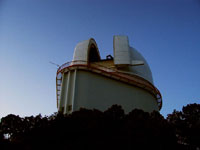The McDonald Observatory
It’s remarkably dark on top of Mount Locke as well it should be. At 6,800 feet above sea level, the air is clear and thin. When I was there in June, the temperatures were brisk. So much so, many of the people sitting in the dark in the broad, outdoor amphitheater wore sweaters or hoodies to insulate themselves against the cool mountain air.
“Believe it or not, you are on the University of Texas Campus,” boasts the tour leader as he introduces the McDonald Observatory complex before he begins a half hour talk on the planets, constellations, and the universe at large.

Nearly eighty years later, the observatory and scientists from all over the world convene on the mountaintop to study the infinite mysteries of the universe. To help them with their job is an 82-inch, a 36-inch, and 107-inch reflector telescopes. Along with the traditional telescopes, the observatory also has a 30-inch lunar laser rangefinder.
The newest telescope is the Hobby-Eberly Telescope (HET). Constructed in 1994, the specialized telescope breaks down light into component wavelengths in a process known as spectroscopy.
From just outside the visitor’s center where I sit with my family, the big telescopes are prominent - even in the dark. While I listen to the program leader I notice that to the northeast, the HET beams a green laser up to the stars. Almost instantaneously, the speaker notices the beam and tells the crowd that the telescope uses lasers for precise aiming.
Throughout the program, me and about fifty others sit on rock benches and crane our necks skyward as the speaker talks about the location of various planets and constellations. Soon, though, we are released over to a small telescope park where we’ll spend the next hour or so looking at the wonders in the sky.
Through one of the telescopes we see a ring nebulae that looks like a stellar donut. In another is a star cluster by which thousands of stars are packed together and are gravitationally bound. The most awe inspiring sight for me was seeing Saturn, complete with its rings and multiple moons. I don’t know why I was so captivated by Saturn. Perhaps it’s because Earth’s neighbor or maybe it is the celestial body in which I am most familiar. Either way, I stand way too long staring in the telescope’s eyepiece.
“Let’s go, daddy,” insists my nine-year-old daughter as she tugs my t-shirt and beckons me to the next telescope. Her and my son are excited to see the wonders of the universe and my wife and I are glad to oblige their curiosity. Just like my parents did for me.